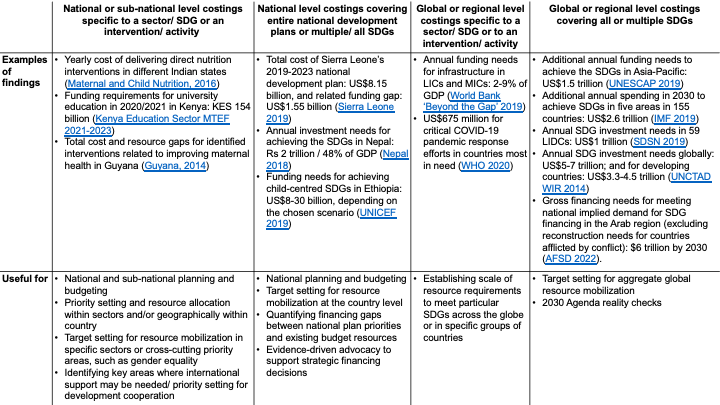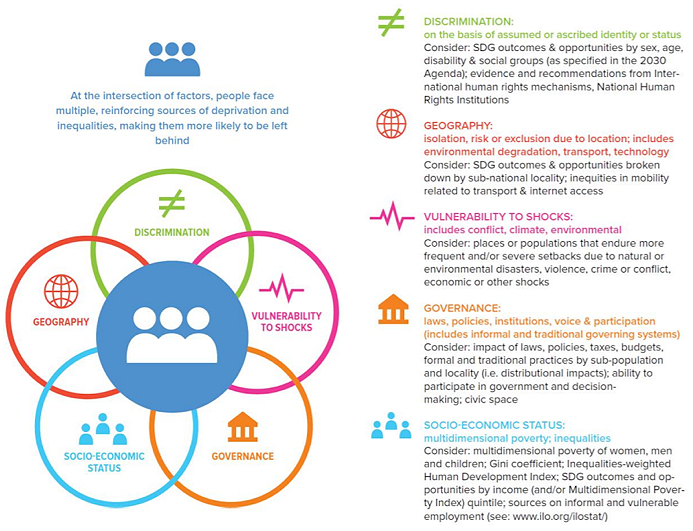The international community also offers a
multitude of sector-specific costing methodologies and tools. They are grounded
in the basic methodologies set out in Figure 3 and Table 2 but incorporate
sector-specific considerations. Boxes 3, 6 and 8 illustrate examples of some of
these, related to health, energy and land use respectively. A more
comprehensive list is included in Table 4 (see Section 4.3).
Some sectors and thematic priorities are more
easily quantifiable than others. For outcomes where interventions are not standardized
or cross-cutting in nature (such as reduced poverty and inequalities or strengthened
governance and institutions), detailed bottom-up costing approaches may be less
suitable. Top-down or modelling-based costing approaches can provide ball-park
estimation of needs. For example, growth models can be used to estimate economy-wide
investment needs to achieve desired poverty reduction outcomes. Alternatively,
as done in Bangladesh’s SDG financing strategy, costs can be estimated by
determining the financing needed to adequately resource relevant institutions.
For example, to estimate the cost of achieving SDG 10 (reduced inequalities), Bangladesh
identified key ministries whose overall budgets would need to be scaled up to
achieve relevant targets. Similarly, in relation to SDG 16 (peace, justice and
strong institutions), it allocated a lump sum to institutional reform along with recurrent budget allocations to
relevant government agencies and departments such as the police force, prisons
and courts.
The choice of methodology and interpretation of results should also be
mindful of other limitations and challenges:
- Sensitivity to
underlying assumptions: changes to production technologies and the policy and
economic environment, both nationally and globally, cannot be fully known but
may significantly impact costs; similarly, economic and non-economic shocks may
derail growth prospects and thus significantly affect spending needs. Scenario-based
approaches could provide a more robust analysis and facilitate better planning as
well as more efficient and effective financing strategies.
- Synergies and
trade-offs: possible synergies/ co-benefits and trade-offs between different
policy objectives or sectors are not always captured, particularly in bottom-up
and sector-specific exercises, meaning that aggregate estimates of cost can be
inflated.
- Policies and
institutions: costing methodologies are able to account for factors such as
absorptive capacity and spending efficiency only to a limited extent.
- Leaving no one
behind: financing needs assessments may struggle to consider distributional
implications and additional costs to reaching the poorest and most marginalized
people.
Step 3: Calculating ‘sustainable development-proof’ cost
estimates
While there are inherent limitations to
costing exercises (see above), practitioners have found ways to address them.
They include: considering different scenarios, risks and potential financial
returns to ensure cost estimates are forward-looking; accounting for all
dimensions of sustainability, including environmental aspects and the leaving
no one behind principle; and accounting for synergies across outcome areas,
sectors and activities.
a) Accounting
for different scenarios, risks and potential financial returns
Growth shocks, natural and man-made hazards, and other events outside a
country’s control, such as Covid-19, as well as changes in policy direction or
development priorities can impact cost estimates. Financing needs assessments,
especially those used for long-term planning and target setting, should thus incorporate
scenarios and flexible forward-looking assumptions, e.g. through policy simulation models. Exploring multiple scenarios also allows
for the identification of possible trade-offs between objectives and inform policy
decisions (e.g. see Box 6).
The risk assessments module (see building block 1.3) provides an
overview of the main types of risk that can affect the country’s financing for
development efforts, including their potential financial consequences. This analysis
can inform a balanced perspective on prevention/ preparedness and response
costs. By taking such a risk-informed perspective, INFF costing exercises
strengthen resilience and help minimise the economic (and human) impacts of potential shocks, disasters and
crises. Box 9 illustrates how Nepal’s SDG costing took the country’s proneness to
earthquakes into account.
Some interventions and investments (e.g.
infrastructure investments or investments to protect ecosystems) generate
future financial benefits, be they new/ expanded fiscal revenue streams or future
savings/ avoided costs. Taking these second-round benefits into account avoids
inflating their ‘real’ and long-term cost to the government. Intertemporal balance
sheet analysis can help policy makers build a more holistic picture of the
actual cost of identified interventions.
b) Accounting
for sustainability
The principle of leaving no one behind underpins the SDGs. It should
guide the articulation of interventions and policies and be taken into account
in costing exercises. For example, the poorest and most vulnerable people
are also most likely to be hardest hit by economic shocks and disasters,
impacting recovery costs. Further, it is essential to ensure costing efforts
account for the gender differentiated impacts of particular interventions. Box 9 illustrates
how leaving no one behind was considered in Nepal’s SDG costing exercise.
The UN
framework for assessing who is being left behind (illustrated in
Figure 4) may be useful to guide the identification of most-at-risk populations
and to inform revisions to cost estimates accordingly. For example, if
populations living in remote areas are at risk of being left behind, then infrastructure
planning and costing should be adjusted to benefit them.










